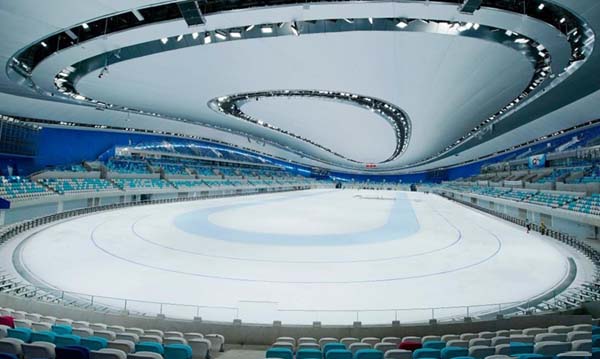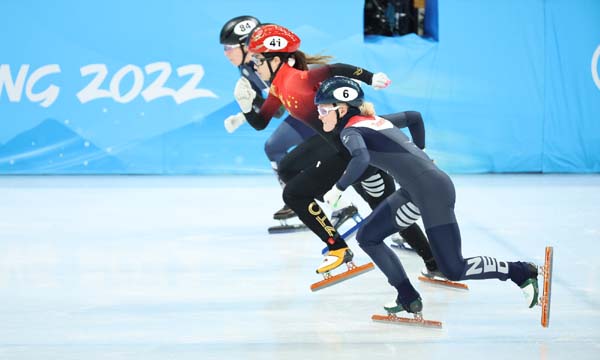
Beijing Olympics: China wins applause for heaven-like experience
Newswire
Beijing: China is winning applause and praise from visiting Olympians for its top-notch venue services, as the world’s first “dual Olympic city” pays attention to the details in every aspect to support the safe and smooth operation of the Games while overcoming the difficulties brought by the COVID-19 pandemic.
When the Winter Olympics meet Chinese New Year, Beijing is making everyone’s stay in China more enjoyable with a wonderful experience of Chinese culture.
Speaking when visiting the Main Media Center on Wednesday, Thomas Bach, president of the International Olympic Committee, told the media that the Beijing venues are so outstanding that all athletes are content and some of them compared the venues to heaven.
Bach commented that it has all gone very smoothly since the opening ceremony and so far all the Games have gone very well, while saying “let’s look forward to the remaining 12 days of competition.”
Officials from four Beijing districts – Chaoyang, Haidian, Shijingshan and Yanqing – explained on Wednesday how they made such amazing services happen, at a special press conference at the 2022 Beijing Media Center.

Home to three competition arenas including the National Stadium and the Aquatics Center (or the Ice Cube), and eight non-competition venues, Chaoyang district will hold 75 competitions and 32 award ceremonies, according to Meng Rui, deputy head of the district.
Meng cited the supporting work for the opening ceremony – for example, the district has mobilized more than 2,800 personnel to work in common areas, ensuring the smooth running of the event.
Meng said that the district has prioritized anti-COVID-19 measures for the Olympics. An area of more than 40,000 square meters that came in contact with the closed-loop personnel at the event was fully disinfected.
The number of Olympic service hotels in Chaoyang district reached 83, and they have received more than 22,000 international guests. More than 1,200 medics have been dispatched to stations in competition venues, relevant hotels and transport stations. Chaoyang has carried out 681,000 nucleic acid tests in an effort to create a safe Olympic event, Meng noted.
Haidian district deputy head Lin Hang, for her part, shed light on the scientific and technological features of the district’s Winter Olympic services. According to Lin, ranging from 8K high-resolution screens to the application of guide and disinfection robots, Haidian fully displayed its unique advantages at every stage of services in the venues located there.
Yuzuru Hanyu, world-renowned Japanese figure skater, spoke highly of the venues of the Beijing Winter Olympics, saying both “the stadium and the ice are brilliant” and “I like it here,” according to the Xinhua News Agency.
He started his training at the Capital Indoor Stadium in Haidian on Monday afternoon, when he began with some jump practices, including the sport’s most difficult jump, a quadruple axel (4A).
To explore the secrets behind ice-making, the Global Times had an exclusive interview with Remy Boehler, an ice master from France, who built the stage of dreams for athletes from all over the world, together with his Chinese colleagues.
Short-track speed skating and figure skating have different styles: one is fast while the other is graceful. Both share the same ice at the Beijing Olympics.
Boehler began to work in ice-making when he was 16 years old, when he drove the ice-sweeping cars at the Albertville Winter Olympics in France in 1992. Since then, he has gained rich experience in several Winter Olympics and world championships.
After working on short-track speed skating and figure skating for the 2018 Pyeongchang Winter Olympics, Boehler was invited by the Beijing Organizing Committee for the Beijing 2022 Games, and he has been working with the Chinese team for nearly four years to deliver an excellent Winter Olympics.

Speaking about the biggest challenge of this job, Boehler said the Capital Stadium will handle the two major events of the Beijing Winter Olympics – short-track speed skating and figure skating, which have completely different requirements on the ice.
“This requires us to study carefully to make sure the ice is perfect for both events,” he said. “Figure skaters are better able to jump on a softer surface than the crisp ice that short-track speed skaters prefer. If a short-track speed skater can skate extremely fast and a figure skater can jump very high in a race, then the ice work is successful.”
Therefore, his ice team has to adjust the temperature of the ice several times a day. “We adjust the condition of the ice, change the protective pads and adjust the temperature of the ice every day to achieve the optimal temperature. In order to achieve this goal, we work closely with the Chinese engineers in charge of machinery and equipment to regulate the ice temperature, water temperature and cooling system temperature.”
The Capital Stadium was built in 1968, the first modern gymnasium in Beijing. China’s first artificial indoor ice rink was also born here.
Shijingshan district, where the Beijing Winter Olympic organizing committee has its headquarters and which is also home to the main operation center, transport direction center and other hub facilities for the Games, has activated nine special Olympic service hotels and established a food security squad to provide technical support, among other efforts to improve the venue services, said district spokesperson Qi Chunli at the Wednesday conference.
Shijingshan district also carried out regular disinfection work in the closed-loop areas as well as daily nucleic acid testing. The district also sent psychologists to stations in hotels and it launched psychological service hotlines to support all personnel working for the Olympics, Qi said.
Shijingshan district is also home to Beijing’s Big Air Shougang Olympic venue that just witnessed the epic victory of 18-year-old Chinese freestyle skier Gu Ailing, also known as Eileen Gu.
Gu has spoken highly of the competition venue in Shijingshan, as she told the media on Tuesday that not only she but also all other athletes said the Shougang Big Air was the best of its kind that they had set foot on.
Beijing’s suburban Yanqing district has set up 39 food service points including seven for competition venues, providing timely and customized food services to some 16,000 athletes and officials, based on their tastes, Huang Keying, a district spokesperson, said on Wednesday.
“We have adjusted the menu according to the preferences of Chinese and foreign guests, and rolled out combos of scores of styles to ensure our foreign friends have a good memory of Chinese cuisine,” Huang said.
According to Huang, Yanqing service personnel organized New Year celebrations such as dumpling making and dragon dances, to give everyone a feel of a joyful Chinese New Year.
To support the snow competitions, which are highly weather reliant, the district also founded a 49-strong-person meteorological support center, deploying an automatic meteorological station, weather radar and other high-tech instruments to provide real-time weather monitoring and minute/100-meter level precise forecast, Huang said.
Bobsledder Carlo Valdes, a member of the US team for the 2022 Winter Olympics, told the Global Times that “Compared to [South] Korea… you can tell that the organizers wanted to do a step up and try to make it better for athletes,” he said. “Given everything going on with COVID and all the limitations, it’s been an awesome experience so far.”
“It’s the coolest track I’ve ever experienced,” he told the Global Times after checking the bobsleigh track in Yanqing, noting that it shows that the amount of time the organizing committee and staff put into the Games has really paid off.
